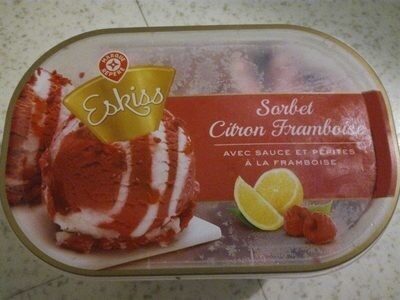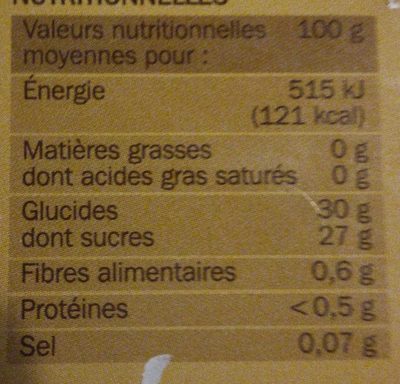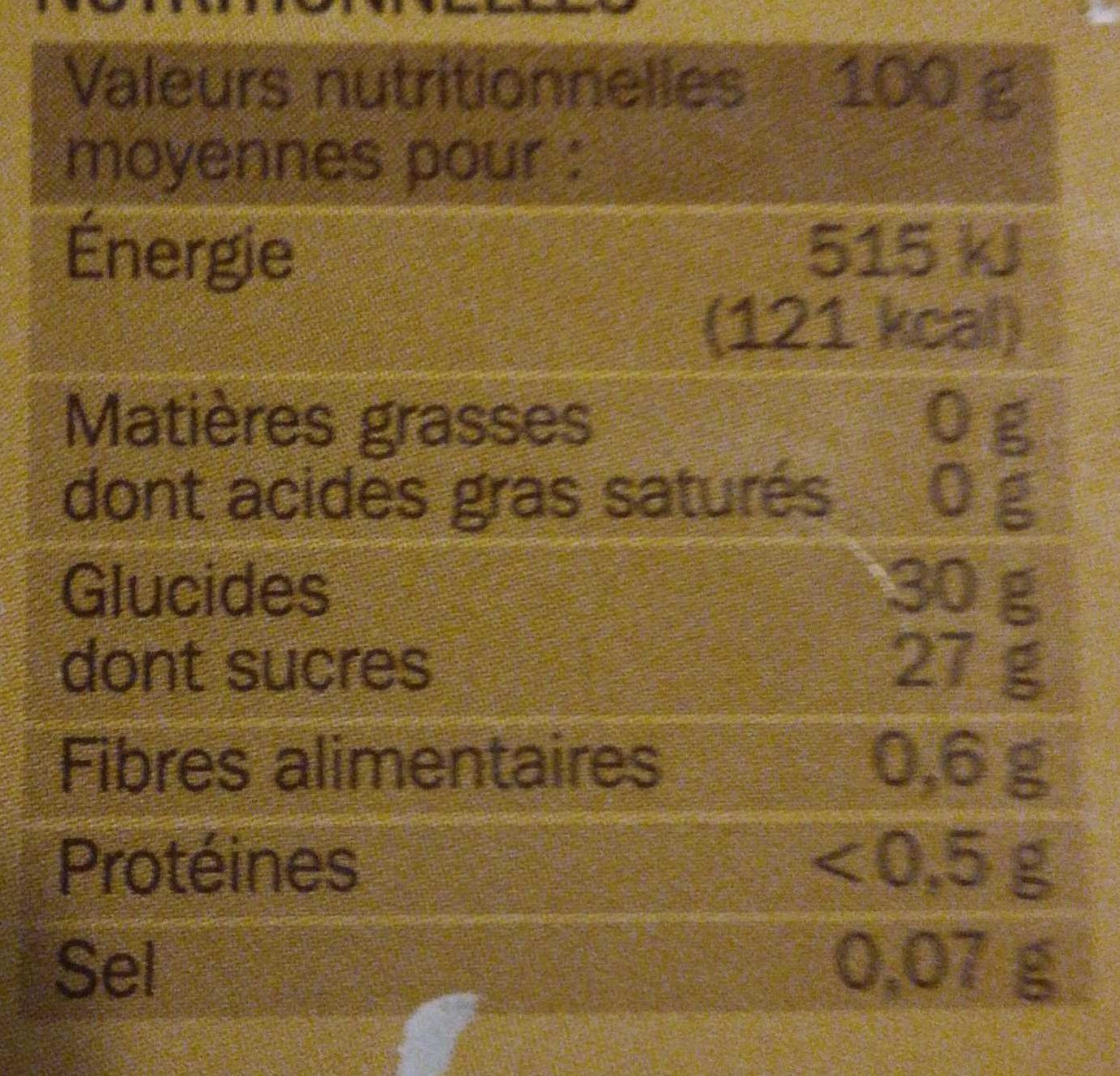Help us make food transparency the norm!
As a non-profit organization, we depend on your donations to continue informing consumers around the world about what they eat.
The food revolution starts with you!
Vrac sorbet citron framboise - Eskiss - 515 g
Vrac sorbet citron framboise - Eskiss - 515 g
This product page is not complete. You can help to complete it by editing it and adding more data from the photos we have, or by taking more photos using the app for Android or iPhone/iPad. Thank you!
×
Some of the data for this product has been provided directly by the manufacturer Scamark.
Barcode: 3564700882221 (EAN / EAN-13)
Quantity: 515 g
Packaging: Plastic, Frozen, Tray
Brands: Eskiss, Marque Repère
Categories: Desserts, Frozen foods, Frozen desserts, Ice creams and sorbets, Sorbets, Multifruit sorbets
Labels, certifications, awards:
Green Dot
Stores: Leclerc
Countries where sold: France
Matching with your preferences
Health
Ingredients
-
33 ingredients
: Eau ; sucre ; jus de citron à base de concentré 17.3 %* ; purée de framboise 11.3 % ** ; sirop de glucose-fructose ; gélifiants : pectines, gomme Tara, gomme xanthane, farine de graines de caroube, gomme guar, alginate de sodium ; arôme naturel de citron ; arôme naturel de framboise ; purée de pomme ; jus concentré de sureau ; protéines de pois hydrolysées ; dextrose ; acidifiant : acide citrique ; fibres d'ananas ; colorants : rouge de betterave, curcumine, anthocyanes ; arôme naturel de framboise avec autres arômes naturels ; jus concentré de citron ; stabilisant : E341 ; correcteur d'acidité : acide citrique. Traces de gluten, oeufs, arachides, soja, lait et fruits à coque. * 26,7 % dans le sorbet au citron ** 30 % dans le sorbet à la framboiseTraces: Eggs, Gluten, Milk, Nuts, Peanuts, Soybeans
Food processing
-
Ultra processed foods
Elements that indicate the product is in the 4 - Ultra processed food and drink products group:
- Additive: E100 - Curcumin
- Additive: E162 - Beetroot red
- Additive: E163 - Anthocyanins
- Additive: E401 - Sodium alginate
- Additive: E412 - Guar gum
- Additive: E415 - Xanthan gum
- Additive: E417 - Tara gum
- Additive: E440 - Pectins
- Ingredient: Colour
- Ingredient: Dextrose
- Ingredient: Flavouring
- Ingredient: Gelling agent
- Ingredient: Glucose
Food products are classified into 4 groups according to their degree of processing:
- Unprocessed or minimally processed foods
- Processed culinary ingredients
- Processed foods
- Ultra processed foods
The determination of the group is based on the category of the product and on the ingredients it contains.
Additives
-
E162 - Beetroot red
Betanin: Betanin, or Beetroot Red, is a red glycosidic food dye obtained from beets; its aglycone, obtained by hydrolyzing away the glucose molecule, is betanidin. As a food additive, its E number is E162. The color of betanin depends on pH; between four and five it is bright bluish-red, becoming blue-violet as the pH increases. Once the pH reaches alkaline levels betanin degrades by hydrolysis, resulting in a yellow-brown color. Betanin is a betalain pigment, together with isobetanin, probetanin, and neobetanin. Other pigments contained in beet are indicaxanthin and vulgaxanthins.Source: Wikipedia
-
E163 - Anthocyanins
Anthocyanin: Anthocyanins -also anthocyans; from Greek: ἄνθος -anthos- "flower" and κυάνεος/κυανοῦς kyaneos/kyanous "dark blue"- are water-soluble vacuolar pigments that, depending on their pH, may appear red, purple, or blue. Food plants rich in anthocyanins include the blueberry, raspberry, black rice, and black soybean, among many others that are red, blue, purple, or black. Some of the colors of autumn leaves are derived from anthocyanins.Anthocyanins belong to a parent class of molecules called flavonoids synthesized via the phenylpropanoid pathway. They occur in all tissues of higher plants, including leaves, stems, roots, flowers, and fruits. Anthocyanins are derived from anthocyanidins by adding sugars. They are odorless and moderately astringent. Although approved to color foods and beverages in the European Union, anthocyanins are not approved for use as a food additive because they have not been verified as safe when used as food or supplement ingredients. There is no conclusive evidence anthocyanins have any effect on human biology or diseases.Source: Wikipedia
-
E330 - Citric acid
Citric acid is a natural organic acid found in citrus fruits such as lemons, oranges, and limes.
It is widely used in the food industry as a flavor enhancer, acidulant, and preservative due to its tart and refreshing taste.
Citric acid is safe for consumption when used in moderation and is considered a generally recognized as safe (GRAS) food additive by regulatory agencies worldwide.
-
E341 - Calcium phosphates
Calcium phosphate: Calcium phosphate is a family of materials and minerals containing calcium ions -Ca2+- together with inorganic phosphate anions. Some so-called calcium phosphates contain oxide and hydroxide as well. They are white solids of nutritious value.Source: Wikipedia
-
E412 - Guar gum
Guar gum (E412) is a natural food additive derived from guar beans.
This white, odorless powder is valued for its remarkable thickening and stabilizing properties, making it a common ingredient in various food products, including sauces, dressings, and ice creams.
When used in moderation, guar gum is considered safe for consumption, with no known adverse health effects.
-
E415 - Xanthan gum
Xanthan gum (E415) is a natural polysaccharide derived from fermented sugars, often used in the food industry as a thickening and stabilizing agent.
This versatile food additive enhances texture and prevents ingredient separation in a wide range of products, including salad dressings, sauces, and gluten-free baked goods.
It is considered safe for consumption even at high intake amounts.
-
E440 - Pectins
Pectins (E440) are natural carbohydrates, predominantly found in fruits, that act as gelling agents in the food industry, creating the desirable jelly-like texture in jams, jellies, and marmalades.
Pectins stabilize and thicken various food products, such as desserts, confectioneries, and beverages, ensuring a uniform consistency and quality.
Recognized as safe by various health authorities, pectins have been widely used without notable adverse effects when consumed in typical dietary amounts.
Ingredients analysis
-
Palm oil free
No ingredients containing palm oil detected
Unrecognized ingredients: fr:dans-le-sorbet-au-citron-30-dans-le-sorbet-a-la-framboiseSome ingredients could not be recognized.
We need your help!
You can help us recognize more ingredients and better analyze the list of ingredients for this product and others:
- Edit this product page to correct spelling mistakes in the ingredients list, and/or to remove ingredients in other languages and sentences that are not related to the ingredients.
- Add new entries, synonyms or translations to our multilingual lists of ingredients, ingredient processing methods, and labels.
If you would like to help, join the #ingredients channel on our Slack discussion space and/or learn about ingredients analysis on our wiki. Thank you!
-
Vegan status unknown
Unrecognized ingredients: fr:dans-le-sorbet-au-citron-30-dans-le-sorbet-a-la-framboiseSome ingredients could not be recognized.
We need your help!
You can help us recognize more ingredients and better analyze the list of ingredients for this product and others:
- Edit this product page to correct spelling mistakes in the ingredients list, and/or to remove ingredients in other languages and sentences that are not related to the ingredients.
- Add new entries, synonyms or translations to our multilingual lists of ingredients, ingredient processing methods, and labels.
If you would like to help, join the #ingredients channel on our Slack discussion space and/or learn about ingredients analysis on our wiki. Thank you!
-
Vegetarian status unknown
Unrecognized ingredients: fr:dans-le-sorbet-au-citron-30-dans-le-sorbet-a-la-framboiseSome ingredients could not be recognized.
We need your help!
You can help us recognize more ingredients and better analyze the list of ingredients for this product and others:
- Edit this product page to correct spelling mistakes in the ingredients list, and/or to remove ingredients in other languages and sentences that are not related to the ingredients.
- Add new entries, synonyms or translations to our multilingual lists of ingredients, ingredient processing methods, and labels.
If you would like to help, join the #ingredients channel on our Slack discussion space and/or learn about ingredients analysis on our wiki. Thank you!
-
Details of the analysis of the ingredients
We need your help!
Some ingredients could not be recognized.
We need your help!
You can help us recognize more ingredients and better analyze the list of ingredients for this product and others:
- Edit this product page to correct spelling mistakes in the ingredients list, and/or to remove ingredients in other languages and sentences that are not related to the ingredients.
- Add new entries, synonyms or translations to our multilingual lists of ingredients, ingredient processing methods, and labels.
If you would like to help, join the #ingredients channel on our Slack discussion space and/or learn about ingredients analysis on our wiki. Thank you!
: Eau, sucre, jus de citron à base de concentré 17.3%, purée de framboise 11.3%, sirop de glucose-fructose, gélifiants (pectines), gomme Tara, gomme xanthane, farine de graines de caroube, gomme guar, alginate de sodium, arôme naturel de citron, arôme naturel de framboise, purée de pomme, jus concentré de sureau, protéines de pois hydrolysées, dextrose, acidifiant (acide citrique), fibres d'ananas, colorants (rouge de betterave), curcumine, anthocyanes, arôme naturel de framboise, arômes naturels, jus concentré de citron, stabilisant (e341), correcteur d'acidité (acide citrique), dans le sorbet au citron ** 30 % dans le sorbet à la framboise 26.7%- Eau -> en:water - vegan: yes - vegetarian: yes - ciqual_food_code: 18066
- sucre -> en:sugar - vegan: yes - vegetarian: yes - ciqual_proxy_food_code: 31016
- jus de citron à base de concentré -> en:lemon-juice-from-concentrate - vegan: yes - vegetarian: yes - ciqual_food_code: 2028 - percent: 17.3
- purée de framboise -> en:raspberry-puree - vegan: maybe - vegetarian: maybe - ciqual_food_code: 13015 - percent: 11.3
- sirop de glucose-fructose -> en:glucose-fructose-syrup - vegan: yes - vegetarian: yes - ciqual_food_code: 31077
- gélifiants -> en:gelling-agent
- pectines -> en:e440a - vegan: yes - vegetarian: yes
- gomme Tara -> en:e417 - vegan: yes - vegetarian: yes
- gomme xanthane -> en:e415 - vegan: yes - vegetarian: yes
- farine de graines de caroube -> en:carob-seed-flour - vegan: yes - vegetarian: yes - ciqual_proxy_food_code: 9410
- gomme guar -> en:e412 - vegan: yes - vegetarian: yes
- alginate de sodium -> en:e401 - vegan: yes - vegetarian: yes
- arôme naturel de citron -> en:natural-lemon-flavouring - vegan: yes - vegetarian: yes
- arôme naturel de framboise -> en:natural-raspberry-flavouring - vegan: maybe - vegetarian: maybe
- purée de pomme -> en:apple-puree - vegan: maybe - vegetarian: maybe - ciqual_food_code: 13050
- jus concentré de sureau -> en:elderberry-juice-concentrate - vegan: yes - vegetarian: yes - ciqual_food_code: 13126
- protéines de pois hydrolysées -> en:hydrolysed-pea-protein - vegan: yes - vegetarian: yes
- dextrose -> en:dextrose - vegan: yes - vegetarian: yes - ciqual_proxy_food_code: 31016
- acidifiant -> en:acid
- acide citrique -> en:e330 - vegan: yes - vegetarian: yes
- fibres d'ananas -> en:pineapple-fibre - vegan: yes - vegetarian: yes
- colorants -> en:colour
- rouge de betterave -> en:e162 - vegan: yes - vegetarian: yes
- curcumine -> en:e100 - vegan: yes - vegetarian: yes
- anthocyanes -> en:e163 - vegan: yes - vegetarian: yes
- arôme naturel de framboise -> en:natural-raspberry-flavouring - vegan: maybe - vegetarian: maybe
- arômes naturels -> en:natural-flavouring - vegan: maybe - vegetarian: maybe
- jus concentré de citron -> en:concentrated-lemon-juice - vegan: yes - vegetarian: yes - ciqual_food_code: 2028
- stabilisant -> en:stabiliser
- e341 -> en:e341 - vegan: yes - vegetarian: yes
- correcteur d'acidité -> en:acidity-regulator
- acide citrique -> en:e330 - vegan: yes - vegetarian: yes
- dans le sorbet au citron ** 30 % dans le sorbet à la framboise -> fr:dans-le-sorbet-au-citron-30-dans-le-sorbet-a-la-framboise - percent: 26.7
Nutrition
-
Average nutritional quality
This product is not considered a beverage for the calculation of the Nutri-Score.
Positive points: 0
- Proteins: 0 / 5 (value: 0.5, rounded value: 0.5)
- Fiber: 0 / 5 (value: 0.6, rounded value: 0.6)
- Fruits, vegetables, nuts, and colza/walnut/olive oils: 0 / 5 (value: 28.7, rounded value: 28.7)
Negative points: 6
- Energy: 1 / 10 (value: 515, rounded value: 515)
- Sugars: 5 / 10 (value: 27, rounded value: 27)
- Saturated fat: 0 / 10 (value: 0, rounded value: 0)
- Sodium: 0 / 10 (value: 40, rounded value: 40)
The points for proteins are counted because the negative points are less than 11.
Nutritional score: (6 - 0)
Nutri-Score:
-
Nutrient levels
-
Fat in low quantity (0%)
What you need to know- A high consumption of fat, especially saturated fats, can raise cholesterol, which increases the risk of heart diseases.
Recommendation: Limit the consumption of fat and saturated fat- Choose products with lower fat and saturated fat content.
-
Saturated fat in low quantity (0%)
What you need to know- A high consumption of fat, especially saturated fats, can raise cholesterol, which increases the risk of heart diseases.
Recommendation: Limit the consumption of fat and saturated fat- Choose products with lower fat and saturated fat content.
-
Sugars in high quantity (27%)
What you need to know- A high consumption of sugar can cause weight gain and tooth decay. It also augments the risk of type 2 diabetes and cardio-vascular diseases.
Recommendation: Limit the consumption of sugar and sugary drinks- Sugary drinks (such as sodas, fruit beverages, and fruit juices and nectars) should be limited as much as possible (no more than 1 glass a day).
- Choose products with lower sugar content and reduce the consumption of products with added sugars.
-
Salt in low quantity (0.1%)
What you need to know- A high consumption of salt (or sodium) can cause raised blood pressure, which can increase the risk of heart disease and stroke.
- Many people who have high blood pressure do not know it, as there are often no symptoms.
- Most people consume too much salt (on average 9 to 12 grams per day), around twice the recommended maximum level of intake.
Recommendation: Limit the consumption of salt and salted food- Reduce the quantity of salt used when cooking, and don't salt again at the table.
- Limit the consumption of salty snacks and choose products with lower salt content.
-
-
Nutrition facts
Nutrition facts As sold
for 100 g / 100 mlAs sold
per serving (57.2 g)Compared to: Multifruit sorbets Energy 515 kj
(123 kcal)295 kj
(71 kcal)+4% Fat 0 g 0 g -100% Saturated fat 0 g 0 g -100% Carbohydrates 30 g 17.2 g +9% Sugars 27 g 15.4 g +18% Fiber 0.6 g 0.343 g -53% Proteins 0.5 g 0.286 g -7% Salt 0.1 g 0.057 g +265% Fruits‚ vegetables‚ nuts and rapeseed‚ walnut and olive oils 28.7 % 28.7 % Fruits‚ vegetables‚ nuts and rapeseed‚ walnut and olive oils (estimate from ingredients list analysis) 28.6 % 28.6 %
Environment
-
Eco-Score B - Low environmental impact
⚠ ️Select a country in order to include the full impact of transportation.The Eco-Score is an experimental score that summarizes the environmental impacts of food products.→ The Eco-Score was initially developped for France and it is being extended to other European countries. The Eco-Score formula is subject to change as it is regularly improved to make it more precise and better suited to each country.Life cycle analysis
-
Average impact of products of the same category: A (Score: 87/100)
Category: Sorbet, on stick
Category: Sorbet, on stick
- PEF environmental score: 0.22 (the lower the score, the lower the impact)
- including impact on climate change: 1.07 kg CO2 eq/kg of product
Stage Impact Agriculture
52.7 %Processing
14.6 %Packaging
9.9 %Transportation
11.2 %Distribution
7.4 %Consumption
4.2 %
Bonuses and maluses
-
Missing origins of ingredients information
Malus: -5
⚠ ️ The origins of the ingredients of this product are not indicated.
If they are indicated on the packaging, you can modify the product sheet and add them.
If you are the manufacturer of this product, you can send us the information with our free platform for producers.
-
Packaging with a medium impact
Malus: -10
Shape Material Recycling Impact Tray Plastic High
Eco-Score for this product
-
Impact for this product: B (Score: 72/100)
Product: Vrac sorbet citron framboise - Eskiss - 515 g
Life cycle analysis score: 87
Sum of bonuses and maluses: -15
Final score: 72/100
-
Carbon footprint
-
Equal to driving 0.6 km in a petrol car
107 g CO² per 100g of product
The carbon emission figure comes from ADEME's Agribalyse database, for the category: Sorbet, on stick (Source: ADEME Agribalyse Database)
Stage Impact Agriculture
21.9 %Processing
16.9 %Packaging
24.6 %Transportation
28.3 %Distribution
6.0 %Consumption
2.4 %
Packaging
-
Packaging with a medium impact
-
Packaging parts
Tray (Plastic)
-
Packaging materials
Material % Packaging weight Packaging weight per 100 g of product Plastic
-
Transportation
-
Origins of ingredients
Missing origins of ingredients information
⚠ ️ The origins of the ingredients of this product are not indicated.
If they are indicated on the packaging, you can modify the product sheet and add them.
If you are the manufacturer of this product, you can send us the information with our free platform for producers.Add the origins of ingredients for this product Add the origins of ingredients for this product
Other information
Preparation: Nous vous conseillons de sortir le bac du congélateur quelques minutes avant sa dégustation.
Report a problem
-
Incomplete or incorrect information?
Category, labels, ingredients, allergens, nutritional information, photos etc.
If the information does not match the information on the packaging, please complete or correct it. Open Food Facts is a collaborative database, and every contribution is useful for all.
Data sources
Product added on by appericube
Last edit of product page on by packbot.
Product page also edited by beniben, kiliweb, moon-rabbit, openfoodfacts-contributors, org-scamark, scamark, tacite, yuka.ZEt4UU9xVVJtUE1nbGRnVitpeko1ZmhINlozMkRHSG9Ec1lqSVE9PQ, yuka.sY2b0xO6T85zoF3NwEKvlkddcNb3hjn_PkHTul2z7M6NPIS4MOFdvaXib6o.










